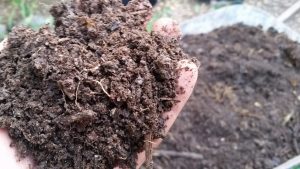By Joseph M. de Leon
Hispanic News Online
Compost is nature’s way of recycling dead plants and animals into new life. You can easily make your own compost for a healthier, more resilient garden.
Soil anchors plants and provides water and nutrients needed to make stalks, leaves, flowers, and fruit. But soil also offers a hidden world of bacteria, worms, and fungus that protect plants from disease and help plants find and eat food they wouldn’t otherwise be able to. Adding compost to garden soil amplifies these benefits.
Compost happens naturally, but making a compost pile helps gardeners accelerate the process. There are many ways to compost, including fermentation, worm bins, and composting with chickens, but I usually recommend hot composting.
It’s called hot composting because when the microorganisms break down the material, they release heat as a byproduct, reaching about 140°F or more. The heat kills potentially harmful pathogens and destroys seeds.
You need five things for hot composting:
Compost area — area of the yard that’s away from the house, but easy to get to; it’s best to stay out of direct sunlight or the pile can dry up and it’s no fun working compost in full sun
“Green” (nitrogen-rich) material — kitchen scraps, manure (avoid poop from carnivores, like cats or dogs), coffee grounds, spent garden plants (avoid diseased plants, seeds, and weeds), grass clippings
“Brown” (carbon-rich) material — dried leaves, paper
Water — make sure a water hose reaches your compost area
Oxygen — you’ll add oxygen when you “turn” or mix the material together
It’s best to compost in an area that’s about 1 cubic yard in size — 3x3x3 feet. It’s easier to manage than larger piles and a smaller volume won’t break down as fast or easily. The ideal mix is about 30 percent “green” material with about 70 percent “brown” material. Mix the material together with a garden fork and water it until it’s the consistency of a wrung-out sponge.
You need a critical mass of material for hot composting to work. The faster you fill the bin, the quicker and more completely it will break down. Consider asking your neighbors or coworkers to save their organic material. Many coffee shops set aside coffee grounds, an excellent way to add loads of “green” material (it’s high in nitrogen, which is why it’s called “green” in compost circles).
Turn the compost pile at least once a week, working all the way to the bottom. This helps break up bigger chunks, distribute moisture, and add oxygen the microorganisms need to live. Add water whenever the pile is drier than a wrung-out sponge.
Too much “green” material will stink like rotting food (mix in more “brown”). Too much “brown” material will slow the decomposition and make it easier for the pile to dry out (mix in more “green” and water, if needed). Too much water can drown the microorganisms and make the pile stink (turn every day until the pile has the right moisture level and consider adding more “brown”).

It takes about 3 to 5 months for compost to be finished. The pile will shrink to about a third of its original size, it’ll no longer be hot, and it’ll smell like rich soil on a rainy day. Once the compost is finished, use it right away or store it in a ventilated container for up to a month in a cool, moist place.
Before planting for the season, mix 2 inches of compost into the top 6-8 inches of a garden bed or mix a trowel of finished compost into each planting hole. To make compost tea, mix 1 shovel of compost into 5-gallons water and mix daily for 3-4 days, then strain out solids, and use immediately. Dilute with 10 parts water and spray on leaves once a week.
Finished compost and compost tea can also be used as a “side dressing.” One handful of compost or one cup of tea per plant is enough per dressing. One side dressing at planting and again at midseason is usually enough until harvest. Summer fruiting crops like tomatoes, peppers, and eggplants should be side dressed when flowers form and as fruits develop.
Featured Photo — Chickens quickly reduce food scraps into finished compost in as little as 3 months. Their constant scratching breaks the material down and their poop adds additional nitrogen. Photo: Joseph M. de Leon
Originally from San Antonio, Joseph has managed a community garden, led a food rescue nonprofit, and was recognized as a City of Austin Net-Zero Hero for his community composting work. He and wife Denise sold everything to buy an RV and travel full time.



